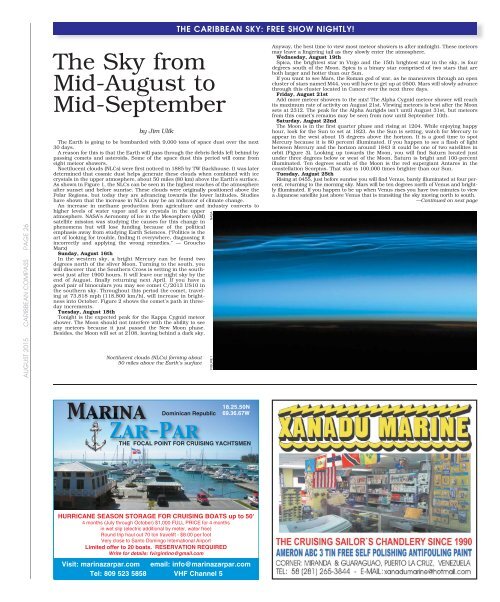Caribbean Compass Yachting Magazine August 2015
Welcome to Caribbean Compass, the most widely-read boating publication in the Caribbean! THE MOST NEWS YOU CAN USE - feature articles on cruising destinations, regattas, environment, events...
Welcome to Caribbean Compass, the most widely-read boating publication in the Caribbean! THE MOST NEWS YOU CAN USE - feature articles on cruising destinations, regattas, environment, events...
You also want an ePaper? Increase the reach of your titles
YUMPU automatically turns print PDFs into web optimized ePapers that Google loves.
THE CARIBBEAN SKY: FREE SHOW NIGHTLY!AUGUST <strong>2015</strong> CARIBBEAN COMPASS PAGE 26The Sky fromMid-<strong>August</strong> toMid-Septemberby Jim UlikThe Earth is going to be bombarded with 9,000 tons of space dust over the next30 days.A reason for this is that the Earth will pass through the debris fields left behind bypassing comets and asteroids. Some of the space dust this period will come fromeight meteor showers.Noctilucent clouds (NLCs) were first noticed in 1885 by TW Backhouse. It was laterdetermined that cosmic dust helps generate these clouds when combined with icecrystals in the upper atmosphere, about 50 miles (80 km) above the Earth’s surface.As shown in Figure 1, the NLCs can be seen in the highest reaches of the atmosphereafter sunset and before sunrise. These clouds were originally positioned above thePolar Regions, but today they are advancing towards the lower latitudes. Studieshave shown that the increase in NLCs may be an indicator of climate change.An increase in methane production from agriculture and industry converts tohigher levels of water vapor and ice crystals in the upperatmosphere. NASA’s Aeronomy of Ice in the Mesosphere (AIM)satellite mission was studying the causes for this change inphenomena but will lose funding because of the politicalemphasis away from studying Earth Sciences. (“Politics is theart of looking for trouble, finding it everywhere, diagnosing itincorrectly and applying the wrong remedies.” — GrouchoMarx)Sunday, <strong>August</strong> 16thIn the western sky, a bright Mercury can be found twodegrees north of the sliver Moon. Turning to the south, youwill discover that the Southern Cross is setting in the southwestjust after 1900 hours. It will leave our night sky by theend of <strong>August</strong>, finally returning next April. If you have agood pair of binoculars you may see comet C/2013 US10 inthe southern sky. Throughout this period the comet, travelingat 73,818 mph (118,800 km/h), will increase in brightnessinto October. Figure 2 shows the comet’s path in threedayincrements.Tuesday, <strong>August</strong> 18thTonight is the expected peak for the Kappa Cygnid meteorshower. The Moon should not interfere with the ability to seeany meteors because it just passed the New Moon phase.Besides, the Moon will set at 2108, leaving behind a dark sky.Noctilucent clouds (NLCs) forming about50 miles above the Earth’s surfaceFIGURE 1 NASAAnyway, the best time to view most meteor showers is after midnight. These meteorsmay leave a lingering tail as they slowly enter the atmosphere.Wednesday, <strong>August</strong> 19thSpica, the brightest star in Virgo and the 15th brightest star in the sky, is fourdegrees south of the Moon. Spica is a binary star comprised of two stars that areboth larger and hotter than our Sun.If you want to see Mars, the Roman god of war, as he maneuvers through an opencluster of stars named M44, you will have to get up at 0500. Mars will slowly advancethrough this cluster located in Cancer over the next three days.Friday, <strong>August</strong> 21stAdd more meteor showers to the mix! The Alpha Cygnid meteor shower will reachits maximum rate of activity on <strong>August</strong> 21st. Viewing meteors is best after the Moonsets at 2312. The peak for the Alpha Aurigids isn’t until <strong>August</strong> 31st, but meteorsfrom this comet’s remains may be seen from now until September 10th.Saturday, <strong>August</strong> 22ndThe Moon is in the first quarter phase and rising at 1204. While enjoying happyhour, look for the Sun to set at 1823. As the Sun is setting, watch for Mercury toappear in the west about 15 degrees above the horizon. It is a good time to spotMercury because it is 80 percent illuminated. If you happen to see a flash of lightbetween Mercury and the horizon around 1843 it could be one of two satellites inorbit (Figure 3). Looking up towards the Moon, you will find Saturn located justunder three degrees below or west of the Moon. Saturn is bright and 100-percentilluminated. Ten degrees south of the Moon is the red supergiant Antares in theconstellation Scorpius. That star is 100,000 times brighter than our Sun.Tuesday, <strong>August</strong> 25thRising at 0455, just before sunrise you will find Venus, barely illuminated at four percent,returning to the morning sky. Mars will be ten degrees north of Venus and brightlyilluminated. If you happen to be up when Venus rises you have two minutes to viewa Japanese satellite just above Venus that is transiting the sky moving north to south.—Continued on next pageMarinaZar-ParDominican Republic18.25.50N69.36.67WTHE FOCAL POINT FOR CRUISING YACHTSMENHURRICANE SEASON STORAGE FOR CRUISING BOATS up to 50'4 months (July through October) $1,000 FULL PRICE for 4 monthsin wet slip (electric additional by meter, water free)Round trip haul out 70 ton travelift - $8.00 per footVery close to Santo Domingo International AirportLimited offer to 20 boats. RESERVATION REQUIREDWrite for details: fvirgintino@gmail.comVisit: marinazarpar.com email: info@marinazarpar.comTel: 809 523 5858 VHF Channel 5


















